Are you aware of the importance of a well-designed stormwater management system in preventing flooding and damage during rainfall events?
A storm drainage system design is crucial for managing stormwater runoff, ensuring it is properly conveyed through a site. Effective stormwater management is essential for reducing erosion and protecting infrastructure. For a comprehensive understanding, let’s explore the key components and best practices involved in designing a functional storm drainage system.
For more detailed information on the steps involved, you can refer to our guide on storm drainage system design for non-professionals, which covers regulatory ordinances, inlet locations, and pipe sizing.
Key Takeaways
- Understanding regulatory requirements for storm drainage system design
- Determining inlet and pipe locations for effective stormwater management
- Preparing hydrology calculations to determine stormwater flow rates
- Designing storm drainage pipe sizes for optimal performance
- Implementing riprap aprons for erosion control
Understanding the Importance of Storm Drainage Systems
The significance of storm drainage systems cannot be overstated in maintaining sustainable urban environments. These systems are designed to manage stormwater runoff, mitigating its impact on urban areas.
Role in Flood Prevention
Storm drainage systems play a critical role in flood prevention by collecting and conveying stormwater runoff. Effective storm drainage reduces the risk of flooding, thereby protecting properties and saving lives.
- Reduces flood risk
- Protects urban infrastructure
- Minimizes environmental damage
Environmental Impact
These systems also have a significant environmental impact. By reducing the amount of stormwater that enters waterways, storm drainage systems help prevent pollution and protect aquatic ecosystems.
- Reduces stormwater pollution
- Protects water quality
- Preserves natural habitats
Protection of Infrastructure
Furthermore, storm drainage systems are essential for the protection of urban infrastructure. By managing stormwater effectively, these systems prevent damage to roads, buildings, and other critical infrastructure.
The importance of maintaining these systems cannot be overstated, as failure to do so can lead to significant economic and social costs.
Key Components of a Storm Drainage System
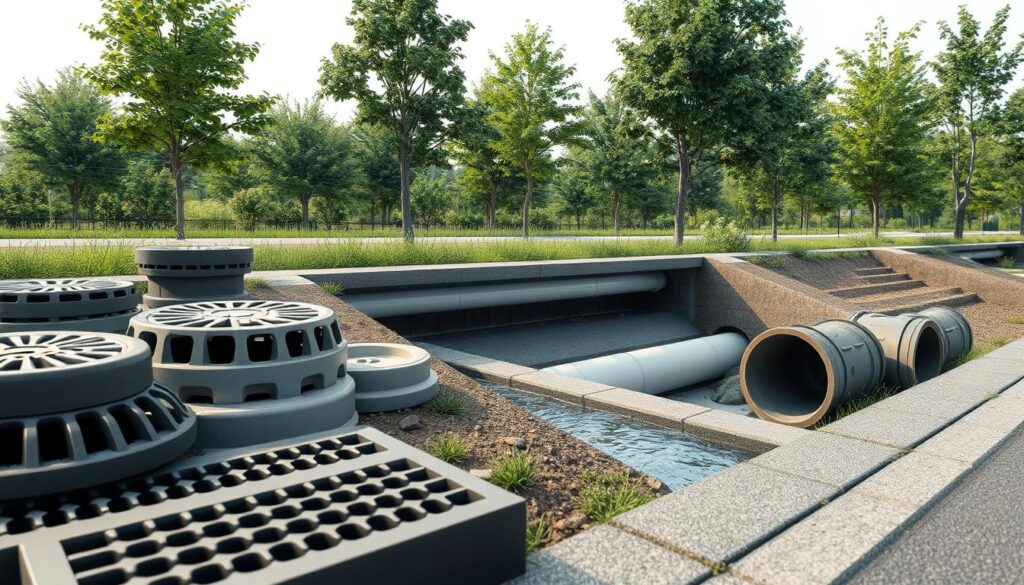
Effective stormwater management requires a comprehensive understanding of the components that make up a storm drainage system. These components work together to collect, convey, and discharge stormwater runoff.
Inlets and Catch Basins
Inlets and catch basins are critical components that collect stormwater runoff from the surface. They are typically designed with grates or gratings to allow water to enter while keeping debris out. Proper design and maintenance of inlets and catch basins are essential to prevent clogging and ensure efficient stormwater collection.
The use of stormwater best practices in designing inlets and catch basins can significantly enhance their effectiveness. For instance, incorporating sediment sumps in catch basins can help reduce the amount of sediment that enters the stormwater pipe system.
Stormwater Pipes
Stormwater pipes convey stormwater runoff from inlets and catch basins to outfalls. These pipes are designed to handle the hydraulic loads imposed by storm events and are typically made from materials like concrete, PVC, or corrugated metal. The selection of pipe material and size is crucial for ensuring the durability and effectiveness of the storm drainage system.
In civil engineering stormwater solutions, the design of stormwater pipes involves careful consideration of factors like pipe slope, roughness, and diameter to minimize the risk of flooding and erosion.
Outfalls and Discharge Points
Outfalls and discharge points are where stormwater runoff is finally discharged into receiving waters like rivers, lakes, or oceans. The design of outfalls is critical to prevent erosion and ensure that the discharged water does not adversely affect the receiving water body.
Effective stormwater best practices at outfalls include energy dissipation measures to reduce the velocity of discharged water and prevent scouring. Additionally, outfalls can be designed with features like diffusers to enhance mixing and reduce the impact on receiving waters.
Types of Storm Drainage Systems
Understanding the different types of storm drainage systems is essential for effective urban planning and flood prevention. Stormwater management is a critical aspect of urban infrastructure, and various approaches can be employed depending on the context and requirements.
Conventional Systems
Conventional storm drainage systems typically involve the use of pipes and culverts to convey stormwater away from urban areas. These systems are designed to quickly transport water to nearby water bodies, thus preventing flooding. However, they often lack the capacity to treat or manage stormwater quality.
Key features of conventional systems include:
- Use of underground pipes and culverts
- Gravity-driven flow
- Direct discharge into water bodies
Green Infrastructure Solutions
Green infrastructure solutions, on the other hand, focus on using natural or semi-natural systems to manage stormwater. These include bioswales, rain gardens, and permeable pavers, which not only reduce stormwater runoff but also improve water quality by filtering out pollutants.
“Green infrastructure is a cost-effective and sustainable approach to managing stormwater, enhancing both environmental quality and community livability.”
| Green Infrastructure | Benefits |
|---|---|
| Bioswales | Reduces runoff, improves water quality |
| Rain Gardens | Enhances biodiversity, aesthetic appeal |
| Permeable Pavers | Reduces surface runoff, allows groundwater recharge |
Combination Systems
Combination systems integrate elements of both conventional and green infrastructure approaches. By combining the efficiency of traditional drainage systems with the sustainability of green infrastructure, these hybrid systems offer a balanced solution for managing stormwater.
The advantages of combination systems include:
- Flexibility in design to suit different urban contexts
- Improved stormwater quality through treatment
- Enhanced resilience to flooding and climate change
In conclusion, the choice of storm drainage system depends on various factors, including urban context, environmental considerations, and budget. By understanding the different types of storm drainage systems available, planners and engineers can design more effective and sustainable stormwater management solutions.
Design Considerations for Storm Drainage
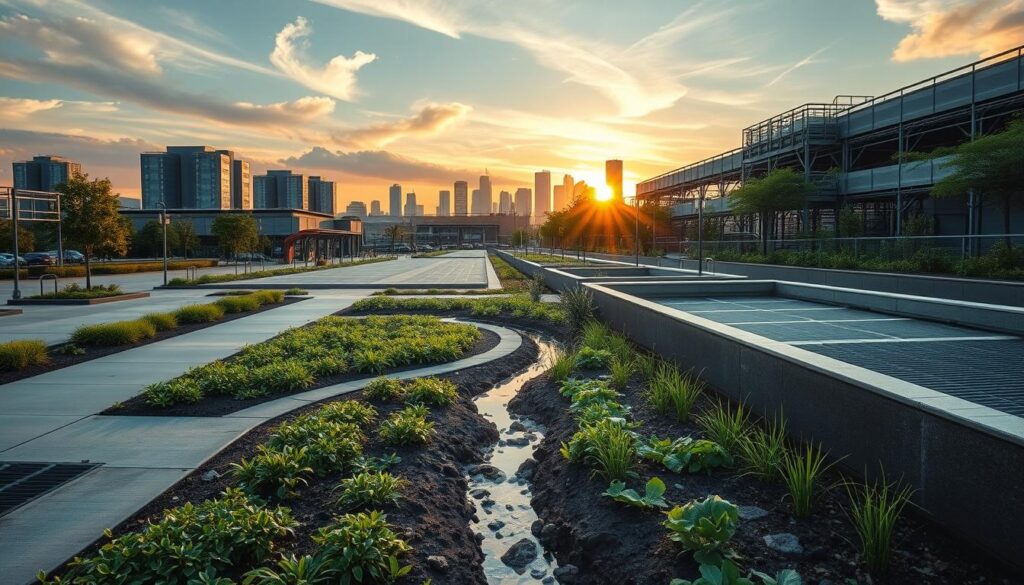
Designing an effective storm drainage system requires a comprehensive understanding of various factors that influence its functionality. A well-designed system is crucial for managing stormwater runoff control and mitigating the risks associated with flooding and environmental degradation.
To achieve this, several key considerations must be taken into account during the design phase. These include assessing the site, understanding local climate and rainfall patterns, and evaluating soil permeability.
Site Assessment and Evaluation
A thorough site assessment is fundamental to designing an effective storm drainage system. This involves evaluating the topography, land use, and existing infrastructure to determine the most suitable design for storm drainage system design. For instance, areas with steep slopes may require specialized drainage solutions to prevent erosion and ensure efficient water flow.
Climate and Rainfall Patterns
Understanding local climate and rainfall patterns is critical in determining the capacity and design of the storm drainage system. Regions with high rainfall intensity may necessitate larger drainage capacities to accommodate the increased water volume. As noted in an article on stormwater design considerations, climate plays a significant role in shaping the design of stormwater management systems.
Soil Permeability
Soil permeability is another crucial factor that influences the design of storm drainage systems. Soils with low permeability may require additional measures to facilitate infiltration and reduce surface runoff. Techniques such as permeable paving and bioswales can be effective in managing stormwater in areas with less permeable soils.
Some key strategies for effective storm drainage design include:
- Conducting thorough site assessments to identify potential challenges and opportunities.
- Utilizing climate and rainfall data to inform design decisions.
- Incorporating green infrastructure solutions to enhance stormwater management.
By considering these factors and incorporating best practices, designers can create storm drainage systems that are not only effective but also sustainable and resilient. Effective stormwater runoff control is essential for protecting infrastructure, reducing environmental impact, and enhancing community safety.
Hydrological Analysis Methods
Understanding hydrological analysis methods is crucial for civil engineers tasked with developing stormwater solutions. Hydrological analysis is a critical step in designing storm drainage systems, as it determines stormwater runoff rates and volumes.
Rational Method
The Rational Method is a widely used technique for estimating peak discharge in small watersheds. It is based on the formula Q = CiA, where Q is the peak discharge, C is the runoff coefficient, i is the rainfall intensity, and A is the drainage area.
Key Considerations for the Rational Method:
- Suitable for small watersheds
- Requires accurate estimation of rainfall intensity and runoff coefficient
- Assumes a uniform rainfall distribution
SCS Curve Number Method
The SCS Curve Number Method, developed by the Soil Conservation Service (now known as the Natural Resources Conservation Service), is used to estimate runoff volume based on soil type, land use, and antecedent moisture conditions.
| Soil Group | Description | Curve Number Range |
|---|---|---|
| A | High infiltration rate | 0-30 |
| B | Moderate infiltration rate | 50-70 |
| C | Low infiltration rate | 70-85 |
| D | Very low infiltration rate | 85-100 |
Hydrograph Analysis
Hydrograph analysis involves studying the temporal distribution of runoff. It is essential for understanding how a watershed responds to rainfall events.
“Hydrograph analysis is a powerful tool for understanding the dynamics of watershed response to rainfall, enabling more accurate design of storm drainage systems.” – Expert in Hydrology
By applying these hydrological analysis methods, civil engineers can design more effective storm drainage systems that mitigate flood risks and manage stormwater runoff efficiently.
Detention and Retention Systems

Detention and retention systems are essential components of modern stormwater management strategies. These systems are designed to manage stormwater runoff by temporarily storing it, thereby reducing the risk of flooding and improving water quality.
Differences Between Detention and Retention
The primary difference between detention and retention systems lies in their approach to managing stormwater. Detention systems temporarily store stormwater and release it slowly, mitigating peak flow rates and preventing downstream flooding. In contrast, retention systems retain stormwater for longer periods, allowing it to infiltrate the ground or be used for other purposes.
A key aspect of understanding these systems is recognizing their distinct roles in stormwater management. Detention systems are often used in areas where rapid discharge is not feasible, while retention systems are beneficial for water conservation and groundwater recharge.
| Characteristics | Detention Systems | Retention Systems |
|---|---|---|
| Purpose | Temporary storage and slow release | Long-term retention and infiltration |
| Water Release | Slow release into waterways | Infiltration into groundwater or evaporation |
| Benefits | Flood control, erosion prevention | Water conservation, groundwater recharge |
Design Strategies for Detention Basins
Designing effective detention basins requires careful consideration of several factors, including site topography, soil type, and anticipated stormwater volumes. A well-designed detention basin can significantly reduce downstream flooding and improve water quality.
Key design strategies include:
- Sizing the basin to accommodate expected stormwater volumes
- Incorporating outlet structures to control the release rate
- Ensuring adequate maintenance access
“The design of detention basins must balance the need for flood control with environmental considerations, such as habitat creation and water quality improvement.”
Soil and Site Considerations
Soil permeability and site conditions play a crucial role in the effectiveness of detention and retention systems. Soils with high permeability are ideal for retention systems, as they allow for greater infiltration.
Site assessment should include evaluation of soil types, groundwater levels, and existing hydrology to determine the most suitable system design.
By understanding the differences between detention and retention systems and applying appropriate design strategies, communities can effectively manage stormwater runoff, reducing the risk of flooding and improving water quality.
Best Practices in Storm Drainage System Design
Best practices in storm drainage system design are essential for ensuring the system’s effectiveness and longevity. A well-designed storm drainage system mitigates the risk of flooding, protects infrastructure, and supports environmental sustainability.
Sizing and Capacity Calculations
Accurate sizing and capacity calculations are critical components of storm drainage system design. These calculations ensure that the system can handle the anticipated stormwater runoff without overflowing or causing undue stress on the infrastructure. Effective stormwater drain design principles guide engineers in determining the appropriate size and capacity for the system.
The process involves analyzing historical rainfall data, assessing the watershed area, and considering factors like soil permeability and land use. By doing so, designers can create a system that is both efficient and resilient.
Material Selection and Durability
The selection of materials for the storm drainage system is another crucial aspect of its design. Materials must be durable enough to withstand the corrosive effects of stormwater, as well as the physical stresses of flow and potential debris. Common materials include concrete, PVC, and corrugated metal pipes, each with its advantages and disadvantages.
Durability is key to minimizing maintenance needs and extending the system’s lifespan. The choice of material should be based on factors such as expected flow rates, soil conditions, and environmental considerations.
Maintenance Considerations
Maintenance is an often-overlooked aspect of storm drainage system design. However, a well-designed system incorporates features that facilitate easy maintenance, such as accessible inlets and outlets, and the use of sedimentation basins to capture debris.
Regular maintenance is essential for ensuring the system operates as intended. This includes inspections, cleaning, and repairs. By planning for maintenance during the design phase, engineers can reduce long-term costs and improve the system’s overall performance.
Regulatory Requirements and Standards
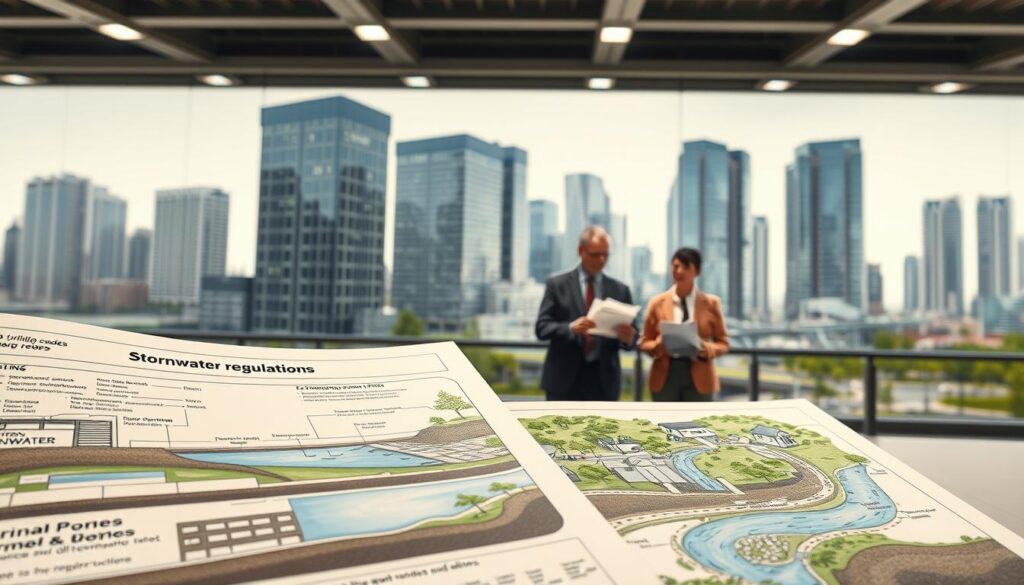
Understanding the regulatory landscape is essential for effective storm drainage system design. Compliance with these regulations is not only mandatory but also crucial for ensuring the system’s functionality and environmental sustainability.
Federal Guidelines
Federal guidelines provide a foundational framework for stormwater management. The Clean Water Act is a pivotal piece of legislation that regulates discharges into U.S. waters, including stormwater runoff. Compliance with federal guidelines involves adhering to standards set for water quality and implementing best management practices (BMPs) for stormwater.
State and Local Regulations
While federal guidelines provide a baseline, state and local regulations often impose more stringent requirements based on regional environmental conditions and infrastructure needs. These regulations may dictate specific design criteria, materials, and maintenance practices for storm drainage systems.
Permitting Process
The permitting process is a critical step in the development of storm drainage systems. It involves submitting detailed plans and documentation to regulatory authorities for approval. This process ensures that the proposed system complies with all relevant regulations and standards.
To navigate the permitting process effectively, designers and developers must be aware of the specific requirements of local and state authorities. This includes understanding the necessary documentation, timelines, and potential hurdles in the approval process.
By adhering to regulatory requirements and standards, storm drainage systems can be designed to not only comply with legal mandates but also to contribute to the overall sustainability and resilience of urban environments.
Sustainable Design Approaches
Sustainable design approaches are revolutionizing the way we manage stormwater runoff. By incorporating green infrastructure into stormwater design, communities can reduce the environmental impact of urbanization. Sustainable drainage systems offer a range of benefits, including enhanced biodiversity and improved ecosystem services.
Bioswales and Rain Gardens
Bioswales and rain gardens are effective tools for managing stormwater at the local level. These green infrastructure solutions capture and filter rainwater, reducing the amount of runoff that enters storm drains. By incorporating native vegetation, bioswales and rain gardens also provide habitat for local wildlife.
The use of bioswales and rain gardens can be particularly beneficial in urban areas, where green spaces are limited. By integrating these features into urban planning, cities can mitigate the effects of stormwater runoff while enhancing community aesthetics.
Permeable Paving Solutions
Permeable paving solutions offer another approach to managing stormwater runoff. By allowing rainwater to percolate through the pavement, permeable paving reduces the amount of stormwater that enters drainage systems. This can help to alleviate pressure on urban drainage infrastructure and reduce the risk of flooding.
Permeable paving can be used in a variety of contexts, from parking lots to pedestrian pathways. When properly designed and maintained, permeable paving can be a durable and effective solution for stormwater management.
Use of Native Vegetation
The use of native vegetation is a key component of sustainable design approaches. Native plants are adapted to local conditions, requiring less maintenance and care. By incorporating native vegetation into stormwater management systems, communities can enhance biodiversity and ecosystem services.
Native vegetation can be used in a variety of stormwater management features, from bioswales to rain gardens. By selecting plants that are well-suited to local conditions, communities can create resilient and effective stormwater management systems.
Stormwater Quality Management
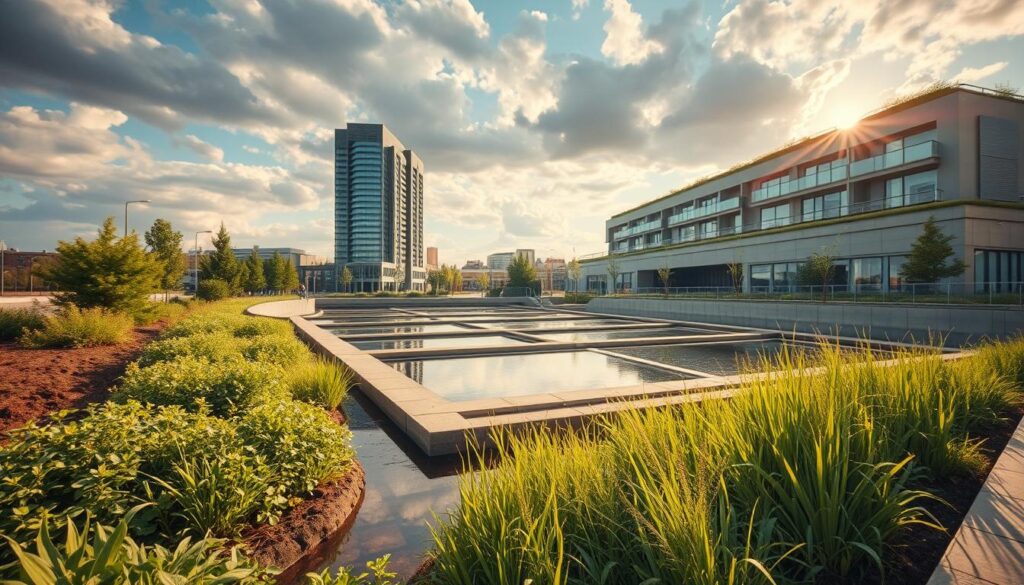
The importance of stormwater quality management cannot be overstated in today’s urban landscapes. As urban areas expand, the impact of stormwater runoff on water quality becomes increasingly significant. Effective stormwater quality management is crucial for protecting receiving waters from a wide array of pollutants.
Stormwater runoff can carry various pollutants, including sediments, nutrients, bacteria, and heavy metals, into water bodies. Pollutant removal techniques are essential for mitigating these impacts. Techniques such as sedimentation, filtration, and biological treatment can significantly reduce pollutant loads.
Pollutant Removal Techniques
Various methods are employed to remove pollutants from stormwater. These include physical processes like sedimentation and filtration, as well as biological processes that utilize vegetation or microorganisms to break down pollutants.
- Sedimentation basins allow particles to settle out of the water.
- Filtration systems, including sand filters and membrane filters, can remove a wide range of pollutants.
- Biological treatment methods, such as wetlands and bioswales, utilize natural processes to improve water quality.
Treatment Practices
Treatment practices for stormwater quality management are diverse and can be tailored to specific site conditions. Best Management Practices (BMPs) are often used to describe these treatment practices, which can include structural measures like detention ponds and non-structural measures such as street sweeping.
Monitoring and Maintenance
Ongoing monitoring and maintenance are critical to ensure the effectiveness of stormwater quality management systems. Regular inspections can identify issues before they become major problems, and maintenance activities such as cleaning catch basins and inspecting pipes can prevent system failures.
In conclusion, stormwater quality management is a multifaceted field that requires a comprehensive approach to mitigate the impacts of urbanization on water quality. By employing effective pollutant removal techniques, implementing appropriate treatment practices, and conducting regular monitoring and maintenance, communities can protect their water resources.
Integration with Urban Planning
The integration of storm drainage systems with urban planning is essential for sustainable urban development. This holistic approach ensures that stormwater management is aligned with broader urban development goals, enhancing the overall resilience and functionality of urban infrastructure.
Zoning and Land Use Considerations
Effective integration begins with zoning and land use planning, which dictates how land is utilized within urban areas. By considering stormwater management in zoning regulations, cities can reduce the risk of flooding and improve water quality. For instance, zoning laws can encourage the use of green spaces that double as stormwater management areas.
Transportation Infrastructure Impacts
Storm drainage design must also consider transportation infrastructure impacts. Roads, highways, and public transportation systems can significantly affect stormwater flow and accumulation. By integrating storm drainage planning with transportation infrastructure design, cities can mitigate the risk of flooding on roads and ensure the continuity of transportation services during heavy rainfall events.
Community Engagement and Education
Community engagement is a critical component of successful storm drainage system integration with urban planning. Educating the public about the importance of stormwater management and involving them in the planning process can foster a sense of ownership and responsibility. This can be achieved through public meetings, educational programs, and collaborative planning initiatives that encourage community input.
By adopting a comprehensive approach to storm drainage system design that includes zoning, transportation infrastructure, and community engagement, cities can create more sustainable and resilient urban water infrastructure. This not only enhances the quality of life for urban residents but also supports environmental sustainability and economic vitality.
Challenges in Storm Drainage Design
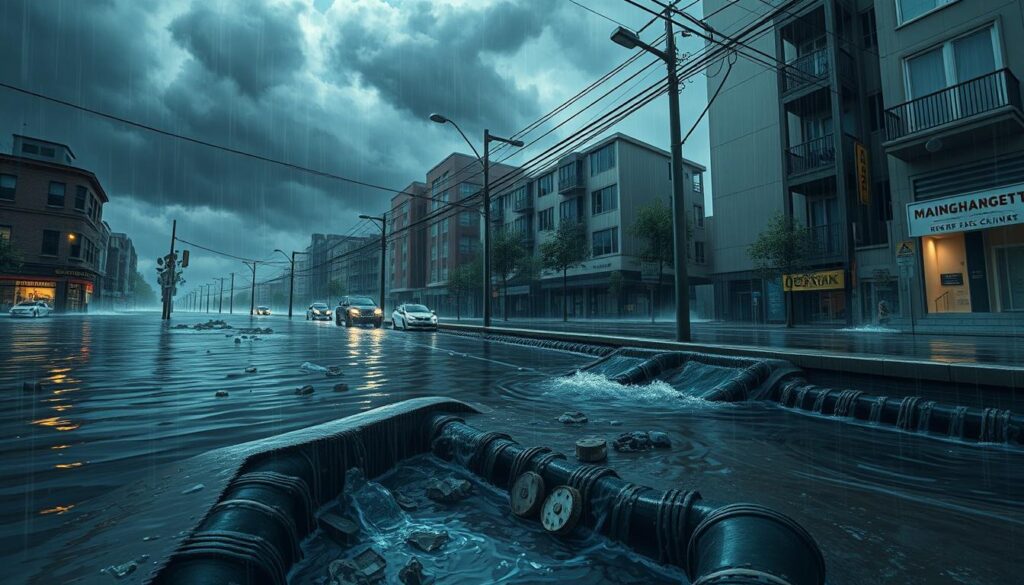
Climate change, urbanization, and aging infrastructure are redefining the landscape of storm drainage design. As the world grapples with these challenges, the need for resilient and adaptable storm drainage systems has become more pressing than ever.
Climate Change Implications
The impact of climate change on storm drainage systems is profound. Rising temperatures are altering precipitation patterns, leading to more frequent and intense storms. This shift necessitates the design of storm drainage systems that can accommodate increased rainfall volumes and velocities. Adaptation strategies are crucial to mitigate the effects of climate change on stormwater management.
Urbanization Effects
Urbanization significantly affects storm drainage design by increasing the amount of impervious surfaces. This change reduces the ground’s ability to absorb water, resulting in higher runoff volumes and velocities. Effective storm drainage systems in urban areas must be designed to handle these increased flows, incorporating sustainable practices such as green infrastructure to mitigate urban flooding.
Aging Infrastructure
Aging infrastructure poses a significant challenge to storm drainage design. Many existing storm drainage systems are outdated and lack the capacity to handle modern rainfall events. Upgrading or replacing these systems is essential to prevent flooding and ensure public safety. Innovative rehabilitation techniques can extend the life of aging infrastructure, but in many cases, complete replacement is necessary.
In conclusion, addressing the challenges in storm drainage design requires a multifaceted approach that considers climate change, urbanization, and aging infrastructure. By understanding these challenges and implementing effective design strategies, communities can develop resilient storm drainage systems that protect both people and the environment.
Future Innovations in Storm Drainage Systems
The future of storm drainage is being shaped by innovative technologies that promise to enhance the efficiency, resilience, and sustainability of stormwater management. As urbanization continues to grow, the need for advanced storm drainage systems becomes increasingly important.
One of the key areas of innovation is the integration of smart technologies and IoT solutions. These technologies enable real-time monitoring and management of stormwater systems, allowing for quicker response times to heavy rainfall events and reducing the risk of flooding.
Smart Technologies and IoT Solutions
The use of smart technologies in storm drainage involves the deployment of sensors and IoT devices to monitor water levels, flow rates, and water quality. This data is then used to optimize system performance and predict potential issues before they become major problems.
- Real-time monitoring of stormwater levels and flow
- Predictive maintenance to prevent system failures
- Enhanced water quality monitoring
For more information on how engineering is tackling future challenges, visit this resource on engineering the future.
Adaptive Management Strategies
Adaptive management strategies are also crucial for the future of storm drainage. These strategies involve designing systems that can adapt to changing climate conditions, such as increased rainfall intensity and frequency.
- Designing systems with flexibility to accommodate future changes
- Incorporating green infrastructure to enhance resilience
- Regularly updating and refining management plans based on new data
Case Studies of Innovative Designs
Several cities have already implemented innovative storm drainage designs that showcase the potential of these new approaches. For example, the use of bioswales and permeable paving in urban areas has been shown to effectively reduce stormwater runoff and improve water quality.
These case studies demonstrate the importance of embracing innovation in storm drainage design to create more sustainable and resilient urban environments.
Case Studies: Successful Storm Drainage Systems
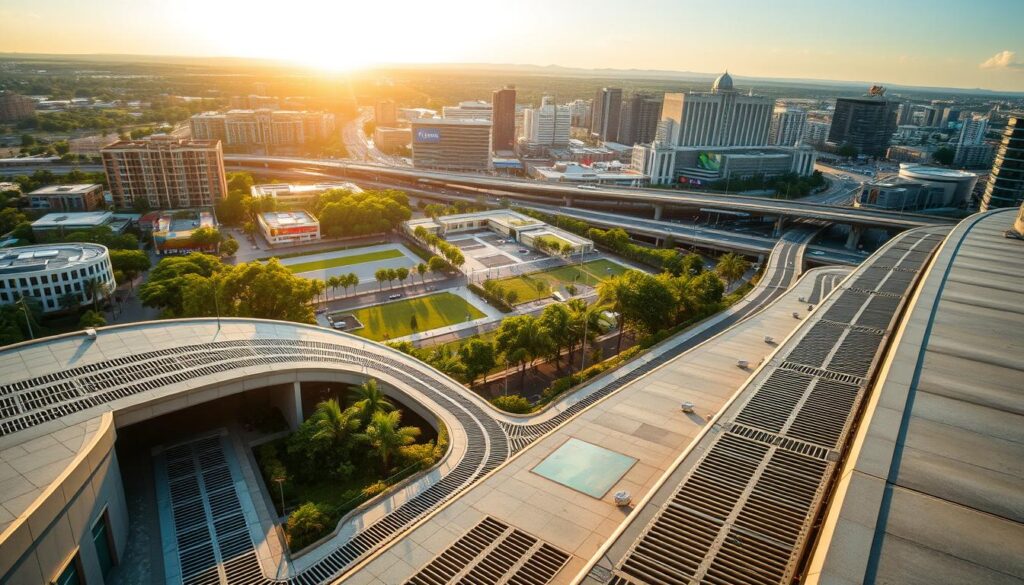
Examining case studies of storm drainage systems reveals valuable insights into effective design strategies, both in urban and rural contexts. These examples provide practical lessons and highlight the importance of adapting designs to different environmental conditions.
Urban Case Study Examples
In urban areas, successful storm drainage systems are critical for managing high volumes of runoff. For instance, the city of Chicago has implemented a comprehensive stormwater management plan that includes green infrastructure such as bioswales and permeable pavers. This approach has significantly reduced urban flooding and improved water quality.
Another example is the stormwater management system in Copenhagen, which incorporates advanced technologies like smart sensors and real-time data analytics to optimize drainage performance. Such innovations demonstrate the potential for integrating technology with traditional infrastructure to enhance resilience.
Rural Solutions and Adaptations
Rural areas face unique challenges in storm drainage due to larger land areas and varied terrain. In the United States, rural communities have adopted innovative solutions such as natural detention basins and wetland restoration to manage stormwater. These approaches not only mitigate flood risks but also provide habitat for wildlife.
A notable example is the use of agricultural BMPs (Best Management Practices) in rural areas, which include practices like contour farming and buffer strips. These methods help reduce runoff and improve water quality, showcasing the effectiveness of non-structural measures in stormwater management.
Lessons Learned
Analyzing these case studies yields several key lessons for designing successful storm drainage systems. Firstly, the importance of context-specific design cannot be overstated; systems must be tailored to the local climate, soil conditions, and land use. Flexibility in design allows for adaptation to changing conditions, such as increased rainfall due to climate change.
“The future of storm drainage lies in integrating green infrastructure with smart technologies to create resilient and adaptive systems.”
Secondly, community engagement and education are crucial for the long-term success of storm drainage projects. By involving local stakeholders in the planning process, projects can better meet community needs and ensure sustainability.
Cost Analysis of Storm Drainage Projects
Understanding the costs associated with storm drainage projects is vital for their successful execution. A thorough cost analysis is essential for planning and implementing these projects effectively.
Budgeting for Design and Implementation
The initial step in cost analysis involves budgeting for the design and implementation phases of storm drainage projects. This includes estimating costs for materials, labor, and equipment necessary for constructing the drainage system. It’s crucial to consider the complexity of the design and the technology used, as these factors significantly impact the overall cost.
For instance, the use of advanced software for hydrological analysis can enhance the accuracy of the design but may increase initial costs. According to the EPA guidelines, a detailed analysis of the site conditions is necessary to determine the most appropriate design.
Long-term Maintenance Costs
Long-term maintenance costs are a critical component of the overall cost analysis. These costs include regular inspections, cleaning, and repairs to ensure the storm drainage system operates efficiently over its lifespan. The selection of durable materials and construction methods can minimize maintenance needs and reduce long-term expenses.
Effective maintenance strategies can significantly extend the life of the storm drainage system, providing long-term savings. For example, implementing a regular cleaning schedule can prevent clogs and reduce the need for costly repairs.
Funding Sources and Grants
Identifying potential funding sources and grants is a vital aspect of cost analysis for storm drainage projects. Various government agencies and organizations offer financial assistance for infrastructure projects that meet specific criteria, such as environmental sustainability or community benefit.
Exploring these opportunities can help offset the costs associated with designing and implementing storm drainage systems. It’s essential to research and apply for relevant grants and funding programs to support the project’s financial viability.
Conclusion: The Future of Storm Drainage Design
The future of storm drainage design is closely tied to the adoption of best practices, ongoing research, and innovation. As urbanization continues to shape our environments, the need for effective stormwater management becomes increasingly important.
Effective Strategies for Stormwater Management
By embracing best practices in storm drainage design, such as sustainable design approaches and stormwater quality management, we can create more resilient and sustainable systems. This includes incorporating green infrastructure solutions, like bioswales and permeable paving, into our urban planning.
Advancing Research and Innovation
Ongoing research is crucial for advancing the field of storm drainage design. By supporting innovation and the development of new technologies, we can improve the efficiency and effectiveness of stormwater management systems.
Promoting Better Practices
It’s essential to promote a call to action for better stormwater management practices. By working together and sharing knowledge, we can create a more sustainable future for our communities. The future of storm drainage design depends on our ability to adapt and evolve in response to changing environmental conditions.
